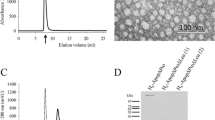Summary
The patterns of the cytolytic effects of 6-hydroxydopamine (6-OHDA), with/without ascorbate, on C-1300 and three other cloned mouse neuroblastoma cell lines (N1E-115, NS-20, N-18) were studied in vitro. The sensitivity to 6-OHDA differed and the three cloned cell lines were more sensitive than the wild type C-1300 cell line. Ascorbate synergistically potentiated the cytolytic effect of 6-OHDA to all four cell lines. The 6-OHDA cytotoxicity was eliminated by the addition of exogenous catalase but not by addition of other oxygen free radical scavengers, thereby suggesting that the hydrogen peroxide formed might influence the cells, extracellularly. In addition, the critical time for tumor cell lysis was the first 60 min of the reaction. The cytotoxicity induced by the unmasked cyclophosphamide, 4-hydroperoxycyclophosphamide, was synergistically enhanced in the presence of a nontoxic concentration of 6-OHDA and ascorbate. These data suggest that reactive oxygen intermediates may prove to be a good tool for destroying neuroblastoma cells.
Similar content being viewed by others
References
Amano T, Richelson E, Nierenberg M (1972) Neurotransmitter synthesis by neuroblastoma clones. Proc Natl Acad Sci USA 69:258–263
Angeletti PU, Levi-Montalcini R (1970a) Sympathetic nerve cell destruction in newborn mammals by 6-hydroxydopamine. Proc Natl Acad Sci USA 65:114–121
Angeletti PU, Levi-Montalcini R (1970b) Cytolytic effect of 6-hydroxydopamine on neuroblastoma cells. Cancer Res 30:2863–2869
Chelmicka-Schorr E, Arnason BGW (1978) Modulatory effect of the sympathetic nervous system on neuroblastoma tumor growth. Cancer Res 38:1374–1375
Cohen G, Heikkila RE (1974) The generation of hydrogen peroxide, superoxide radical and hydroxyl radical by 6-hydroxydopamine dialuric acid, and related cytotoxic agents. J Biol Chem 249:2447–2452
Cronemeyer RL, Thuillez PE, Shows TB, Morrow J (1974) 6-Hydroxydopamine sensitivity in mouse neuroblastoma and neuroblastomaxL-cell hybrids. Cancer Res 34:1652–1657
De Bault LE, Millard SA (1973) Inhibition of growth by 6-hydroxydopamine in cultured cells of neuronal and nonneuronal origin. Cancer Res 33:745–749
Finklestein JZ, Tittle K, Meshnik R, Weiner J (1975) Unorthodox therapy for murine neuroblastoma with 6-hydroxydopamine (NSC-233898), bretylium tosylate (NSC-62164), papaverine (NSC-35443), and butyric acid (NSC-8415). Cancer Chemother Rep 59:571–574
Graham DG, Riffany SM, Bell WR, Butknecht WF (1978) Autoxidation versus covalent binding of quinones as the mechanism of toxicity of dopamine, 6-hydroxydopamine and related compouds toward C-1300 neuroblastoma cells in vitro. Mol Pharmacol 14:644–653
Heikkila RE, Cohen G (1971) Inhibition of biogenic amine uptake by hydrogen peroxide: a mechanism for toxic effects of 6-hydroxydopamine. Science 172:1257–1258
Heikkila RE, Cohen G (1972) Further studies on the generation of hydrogen peroxide by 6-hydroxydopamine potentiation by ascorbic acid. Mol Pharmacol 8:241–248
Heikkila RE, Mytilineous C, Cote LJ, Cohen G (1973) The biochemical and pharmacological properties of 6-aminodopamine: similarity with 6-hydroxydopamine. J Neurochem 21:111–116
Nakagawara A, Nathan CF, Cohn ZA (1981) Hydrogen peroxide in human monocyte during differentiation in vitro. J Clin Invest 68:1243–1252
Prasad KN (1971) Effect of dopamine and 6-hydroxydopamine on mouse neuroblastoma cell in vitro. Cancer Res 31:1457–1460
Prasad KN, Sinha PK, Ramanujam M, Sakamoto A (1979) Sodium ascorbate potentiates the growth inhibitory effect of certain agents on neuroblastoma cells in culture. Proc Natl Acad Sci USA 76:829–832
Reynolds CP, Reynolds DA, Frenkel EP, Smith RG (1982) Selective toxicity of 6-hydroxydopamine and ascorbate for human neuroblastoma in vitro: a model for clearing marrow prior to autologous transplant. Cancer Res 42:1331–1336
Rotman A, Daly JW, Creveling CR, Breukefield SO (1976) Uptake and binding of dopamine and 6-hydroxydopamine in murine neuroblastoma and fibroblast cells. Biochem Pharmacol 25:383–388
Tiffany-Castiglioni E, Perez-Polo JR (1980) Evaluation of methods for determining 6-hydroxydopamine cytotoxicity. In Vitro 16:591–599
Tiffany-Castiglioni E, Saneto PH, Perez-Polo JR (1982) Participation of active oxygen species in 6-hydroxydopamine toxicity to a human neuroblastoma cell line. Biochem Pharmacol 31:181–188
Tranzer JP, Thoenen H (1968) An electron microscopic study of selective, acute degeneration of sympathetic nerve terminals after administration of 6-hydroxydopamine. Experimentia 24:155–156
Tsuruo T, Iida H, Tsukagoshi S, Sakurai Y (1981) Overcoming of vincristine resistance in P388 leukemia in vivo and in vitro through enhanced cytotoxicity of vincristine and vinblastime by verapamil. Cancer Res 41:1967–1972
Author information
Authors and Affiliations
Rights and permissions
About this article
Cite this article
Zaizen, Y., Nakagawara, A. & Ikeda, K. Patterns of destruction of mouse neuroblastoma cells by extracellular hydrogen peroxide formed by 6-hydroxydopamine and ascorbate. J Cancer Res Clin Oncol 111, 93–97 (1986). https://doi.org/10.1007/BF00400743
Received:
Accepted:
Issue Date:
DOI: https://doi.org/10.1007/BF00400743




